Devastation Information, Part 1
I spent the last two weeks talking about Hour of Devastation's design. That means it's time to start telling some card-by-card design stories. As the "Part 1" gives away, I have a lot of stories to tell, so let's get to it.
Abandoned Sarcophagus
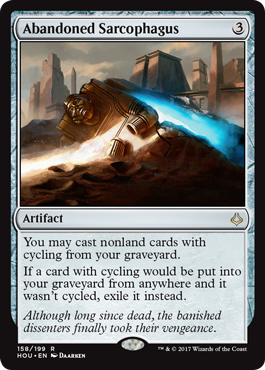
One of the staples of design is to take a block-specific mechanic and design cards to help enable players to build around it. The more linear the strategy (i.e., the more it encourages you play a certain subset of cards—for more on what this R&D vocabulary means, read this article), the easier this is. It's not too hard, for example, to make players using energy cards to want to play with more energy cards, but not every mechanic encourages players to play a lot of it. Cycling is one such example.
There are a bunch of different ways to encourage the use of a specific mechanic. A common way is to have something that triggers on it being used. Another popular way is to have a card that interacts specifically with that type of card. Abandoned Sarcophagus falls into this second category. How can you make a player want a deck full of cycling cards? How about give them a card that makes cycling cards better than normal.
This is cycling's fifth appearance, so it's become a bit harder to find new space for these types of cards. The trick to this design was asking how to give cycling cards extra value in a way we hadn't before. As Amonkhet had a graveyard theme, we asked, was there a way to reward cycling cards that involved the graveyard? Why, yes there was. When cycling cards get used for their cycling ability, they end up in the graveyard. What if we could give them an ability in the graveyard? The big regret when you cycle something is that you'll never get to cast it. What if we changed that so they still could?
I think the earliest version of this card hinted that the artifact basically gives cycling spells a version of flashback. It's both pretty cool and a new way to encourage a cycling deck.
Ammit Eternal
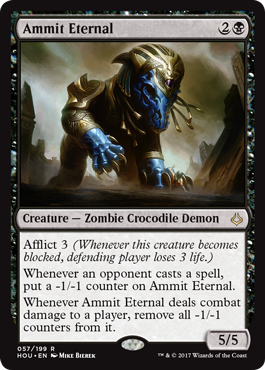
This is a good example of how you can take a mix of different abilities and find a combination where they all come together to make something greater than the sum of their parts. So let's start by looking at the different components:
Afflict 3—Afflict triggers when the creature is blocked, which means there is a huge incentive not to block it. There are two ways to work around this. One, the creature could have a power higher than the afflict number. The opponent blocks it because they'll take less overall damage. Or two, you can have a repercussion for not blocking. The simplest repercussion is what R&D calls a saboteur effect, a triggered effect that happens if the creature deals combat damage to the opponent.
Whenever an opponent casts a spell, put a -1/-1 counter on Ammit Eternal—All colors have cheap creatures with high stats and a drawback, but no color does it as much as black. Black's the color most willing to take a risk to get power. Usually the spells that work with this type of downside are ones where there is significant upside, and the drawback is something you feel you can build your deck to work around. In this case, you are hoping to do enough damage before your opponent can cast enough spells to either kill this or shrink it enough to make it not relevant.
Whenever Ammit Eternal deals combat damage to a player, remove all -1/-1 counters from it—This last ability is both a saboteur ability and a means to offset the drawback of the card. We can start seeing how this design comes together.
One of the things I love about a good design is when each piece of it has a function that works in conjunction with the other pieces of the card. For instance, Ammit Eternal creates a little game with your opponent where they're trying to kill it before it can do too much damage. This means that they want to cast as many spells as they can as fast as they can and they have to do everything in their power to stop it from hitting them once it has a -1/-1 counter on it.
Meanwhile, there's a second game with this card, where the opponent is trying to minimize the amount of damage the card is going to do. Without the other part of the card, this plan is simple: block the creature when it would deal more than 3 damage and don't block it when it would do less (all of this mitigated, of course, by when blocking it can kill it).
The fun part is that often these two games conflict with one another. Allowing the 1/1 through because it deals less than 3 damage is problematic because it can turn back into a 5/5. Add in combat tricks and Ammit Eternal becomes a big headache for your opponent and lots of fun for you.
Angel of Condemnation
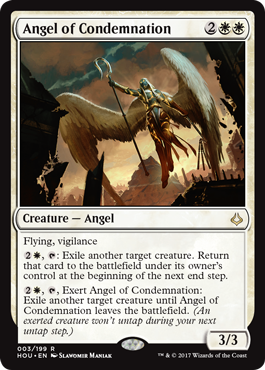
This card is a good example of a style of design that we often do, what I call the tiered effect. A tiered effect is when you want to do two or more effects (although usually just two) that feel connected. Usually, this is done by increasing the power of the effect by turning up a number. A spell can deal 2 damage or, if you jump through the proper hoop, 4 damage. But there are only so many effects that are numerical, so we have to branch out to find other versions.
Angel of Condemnation is an example of what I call the "yes, plus" camp of tiered effects. The way these work is that the first is a simple effect and the second is the simple effect plus something else. Sometimes this is done by simply adding a second ability. For instance, do thing A and, if you jump through a hoop, it turns into a cantrip (R&D slang for drawing a card as a rider to the spell). The trick with the "yes, plus" group of effects is that you want the additive part to feel cohesive to the effect.
Because we have to do these kinds of effects so often, we've learned what two effects that we normally do in isolation can be paired together to create a tiered effect. A classic example that we use all the time is a bounce spell (return target permanent to its owner's hand) that turns into a bounce to top of library spell. Angel of Condemnation pairs together two white effects that, while we do them independently all the time, we rarely do as a tiered effect. The first effect is what we call flicker (named after the first card that did this effect from Urza's Destiny)—exiling a creature until end of turn (some flickering returns it immediately). The second effect is what we call banishing (after Banisher Priest from Magic 2014) where you exile a thing until the permanent that exiled it leaves the battlefield.
When you put the two effects together though, they create a "yes, plus" feel. Either I exile you until end of turn or I exile you until my creature leaves play which, most likely, will be a longer amount of time. Hour of Devastation was introducing exert as a cost on activations, so we were able to use a tiered effect to give you two activations, one requiring exerting and one not.
Apocalypse Demon
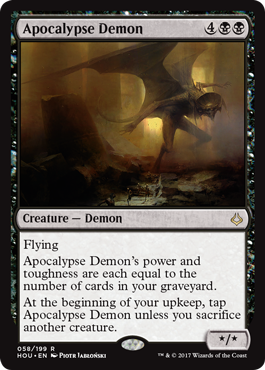
Over the last 24 years, Magic has made over 16,000 cards. One of the fun things to do when designing new cards is to take two old cards and smoosh them together. Apocalypse Demon is one such example.
The first card was one of the high-profile creatures from Limited Edition (Alpha), Lord of the Pit.
Richard Garfield wanted to have a top-down Demon, so he created a card that was powerful and potent, but only if you were able to continually feed it. We've made numerous variants of Lord of the Pit over the years, with various different drawbacks if you're unable to pay for its upkeep. The most common repercussion we use now is that we tap the creature so you aren't able to attack or block with it.
The second card was a high-profile card from Ice Age:
Lhurgoyf was a made-up monster that ate the dead and thus had its power and toughness tied to the number of creatures in all graveyards. We soon realized that this ability worked just as well in black as green and made numerous black Lhurgoyf variants over the years. One of the tweaks we made was caring not just about creature cards but about all cards in a graveyard.
Both Lord of the Pit and Lhurgoyf have become templates for a certain style of creature. Apocalypse Demon is the first time these two different templates have intersected to create something both reminiscent and new.
Banewhip Punisher
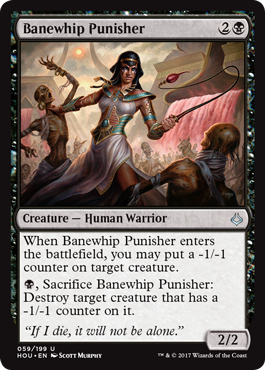
One of my favorites things about being a Magic historian is the context through which I get to look at new designs. Banewhip Punisher, for example, is a new take on a card I made almost 20 years ago. That card was called Bounty Hunter and was in Tempest, the first set I ever led the design for.
Bounty Hunter was a 2/2 for 2BB that allowed you to kill creatures slowly over the course of two turns. I designed the card as a flavorful tweak of Royal Assassin from Alpha, which was able to destroy tapped creatures.
Banewhip Punisher is a modern take on Bounty Hunter. First off, we got rid of the repeatable kill. (Okay, technically, it can kill two creatures if the first creature had 1 toughness and the second creature got a -1/-1 counter through some other means.) Banewhip Punisher is an uncommon, so more aimed at Limited play, where repeatable kill effects become problematic. This was done by forcing the creature to sacrifice itself to kill another creature. This also allowed us to get the mana cost down from 2BB to 2B.
The second big change is how the creature marks something for death. Instead of using a counter with no other function, it makes use of a counter already in use, the -1/-1 counter. This has two advantages. One, when Banewhip Punisher puts a -1/-1 counter on a creature, even if the Banewhip Punisher is destroyed before it can kill the creature, the affected creature still has its power and toughness lowered.
Two, the Banewhip Punisher can use its enters-the-battlefield effect to destroy a 1-toughness creature (or a creature that took enough damage in combat that the -1/-1 will destroy it) and then use its second ability on a creature that got a -1/-1 counter through some other means. This makes Banewhip Punisher more synergistic with the rest of the set and allows for more interactions through gameplay.
Burning-Fist Minotaur
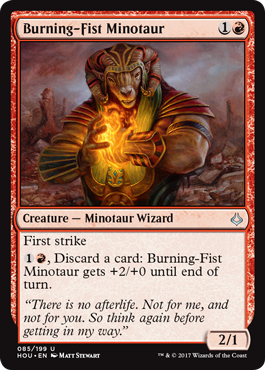
I'm often asked if there are any exercises for aspiring Magic designers. Here's one: randomly pick a card in a new set and see if you can understand why that card was put into the set. What purpose does it serve? This is important because a big part of Magic design is understanding the holistic purpose of a design. Cards aren't created in a vacuum but rather with the goal of forming a unified play experience. So, let's try it right now with Burning-Fist Minotaur. Why is this card in Hour of Devastation?
It's a creature and all sets need a lot of creatures. It's a decently potent two-drop for Limited, allowing red access to its normal aggro strategies. None of this though is hitting the major reason the card is in the set. Here's a hint: it's connected to one of the set's major themes. It's not really top-down. Minotaurs weren't a core part of Egyptian mythology. It doesn't really show off the set's "disaster movie" vibe. It doesn't particularly tie into Nicol Bolas or his Zombie army of Eternals. So what's it up to?
The answer is the graveyard theme. Both Amonkhet and Hour of Devastation have a graveyard component that plays into the ancient Egyptians' obsession with death. Embalm and aftermath as well as eternalize, the embalm variant, all play into this theme. Burning-Fist Minotaur is a graveyard enabler. It does this by giving red the means by which to interact with graveyard strategies. Embalm, eternalize, and aftermath all work while in the graveyard. By having the ability to put cards directly there from your hand, you allow extra interactions. For example, you can discard an aftermath card to boost Burning-Fist Minotaur and then cast the second half of the spell.
One of the questions we always ask is what role can each color play in the various themes. Sometimes that involves having a lot of the mechanic and sometimes that involves having cards that play well with that mechanic. Burning-Fist Minotaur is the latter.
Please feel free to use this technique with other cards to better understand what the designers were up to.
Crested Sunmare
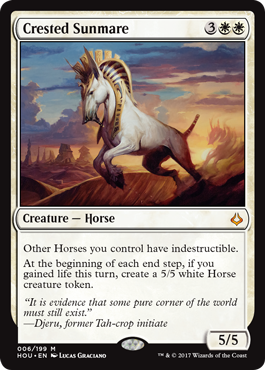
We learned long ago the potency of tribal themes. As such, we make an effort to choose a creature type or two from every block for us to push. (Obviously I'm referring to non-tribal blocks, as in tribal blocks, like Innistrad, we'll push a higher number of creature types.) That is not the only tribal thing we make, though. We also make what I call lower-tier tribal cards. These are cards that encourage you to play a deck of a creature type that gets less support. Often it's something we make at a low level, but through the years have made enough that such a deck is possible. Crested Sunmare is a good example.
According to Gatherer, prior to Hour of Devastation, Magic had 23 Horses. That's not enough for a dedicated Commander deck, but it's enough for a casual Constructed deck that allows four-ofs. The trick to making cards like Crested Sunmare is you have to make something that can enable a tribal deck while still being self-sufficient enough that the card has a value outside of a tribal deck.
Crested Sunmare accomplishes this with what I call an "everything included" design. You see, it makes Horses indestructible, but it also can produce its own Horses. The card doesn't need the deck to have any other Horses, but allows the opportunity if so desired. This makes it work both as a stand-alone card and a build-around card.
Crypt of the Eternals and God-Pharaoh's Faithful
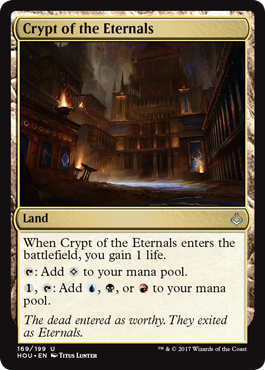
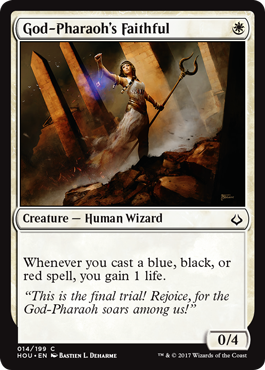
One of the challenges of Hour of Devastation is that it's a Nicol Bolas set but it isn't a primarily multicolor set. Nicol Bolas, through his legendary creature card in Legends as well as his two planeswalker cards in Conflux and Hour of Devastation (as well as a handful of individual spells), has been established as a blue, black, and red character. Was there any way for the set to tip its hat to Bolas's colors while still making the set feel correct? These two cards, along with the Bolas planeswalker card, were an attempt to do this.
First, we made a land that could color wash (turn any mana into another color of mana) for blue, black, and red. We talked about it being Crumbling Necropolis. The name was a good fit, but development didn't want to enable three-color play quite so strongly as the set was not fundamentally a three-color set. Once we changed the land to color washing, we added the life gain trigger to offset the difference. We also allowed the land to tap for colorless mana.
God-Pharaoh's Faithful started as just a card (with different stats) that let you gain life as a trigger off spells being cast, but was tweaked to make it care specifically about Bolas's colors. This design was nice as it didn't encourage you to play all three colors, just play at least one.
We felt that these two cards along with Bolas would give the set just a touch of Bolas's colors.
The Devastation Limitation
We've hit our word count for today, so that means it's time to wrap this up. As always, I'm eager to hear any feedback on either this column or the new set. You can email me or talk to me through any of my social media accounts (Twitter, Tumblr, Google+, and Instagram).
Join me next week for part two of the Hour of Devastation card-by-card design stories.
Until then, may your Hour of Devastation be a little less devastating than it was for the people of Amonkhet.
#448: Other Wizards Games, Part 2
#448: Other Wizards Games, Part 2
Wizards has made many games other than Magic. So many, in fact, that I needed two podcasts to talk about them all.
#449: Counters
#449: Counters
In this podcast, I talk about one of the design tools we use—counters. I go through the various kinds and talk about how counters help us expand what we can do in design.
- Episode 447 Other Wizards Games (26.5 MB)
- Episode 446 20 Lessons: Bluntness (26.7 MB)
- Episode 445 Frames (24.5 MB)

